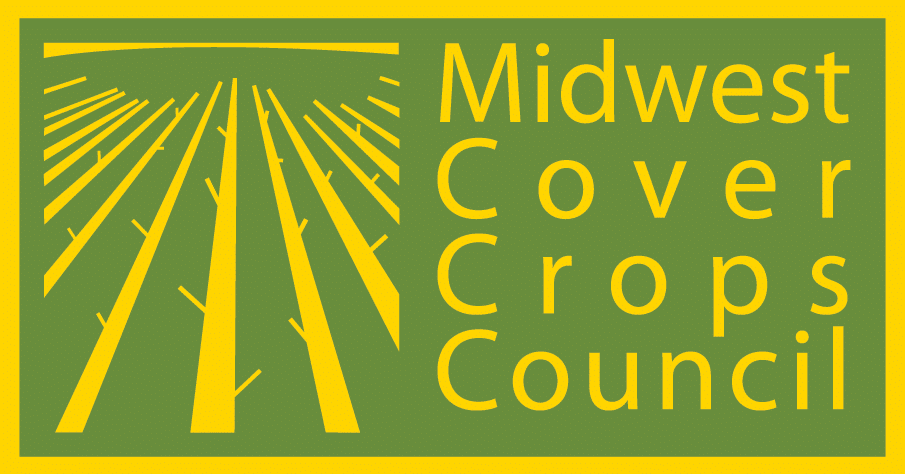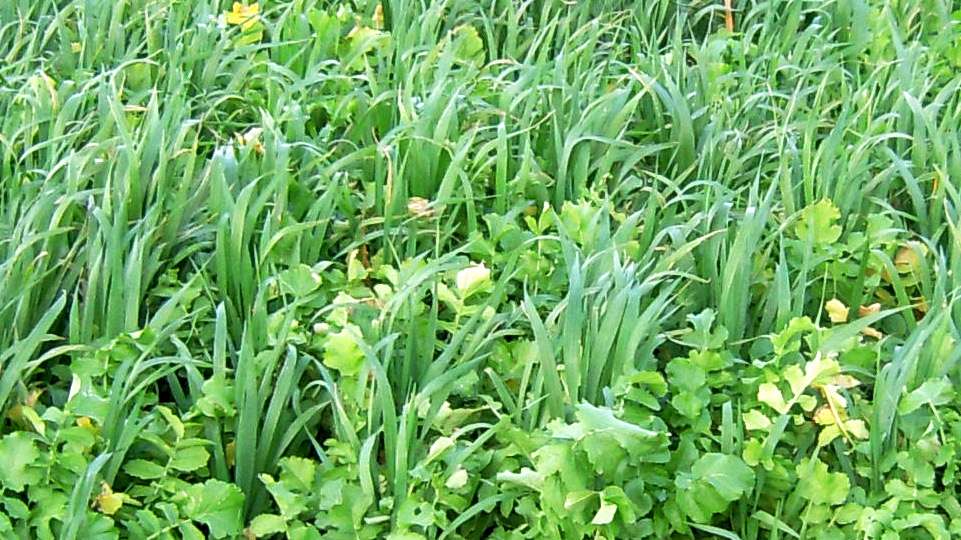Midwest Cover Crops Council (MCCC-113)
University of Missouri Extension (MX82)
This publication is intended to provide a starting point for farmers who are new to growing cover crops. With experience, farmers may fine-tune the use of cover crops for their systems.
Introduction
The following recipe provides an introductory approach to integrating a cover crop into a soybean-corn rotation. Often the easiest place to begin is to plant a cover crop ahead of a soybean cash crop following corn, so consider starting with the companion recipe titled Post Corn, Going to Soybean (publication MCCC-112/MX81; see Resources). Planting cereal rye before corn is discouraged for beginning cover crop users. Experienced cover crop growers can plant it successfully, but it requires changes to nitrogen management and other adjustments.
This publication focuses on cover crops with higher success rates preceding corn, namely (1) a two-way mix of oats and radish for a combination that winterkills and, thus, does not require spring termination or (2) a two-way mix of oats and crimson clover for more erosion control plus living roots through spring. Note that crimson clover terminated in early to mid-April will contribute only minor nitrogen fixation due to limited growth. It needs to grow into about the second week of May before nitrogen contribution from the clover starts to become more substantial. But even a little N fixation is helpful because the clover normally overwinters and it can continue to provide living roots to feed the soil biology while providing a modest level of erosion prevention in combination with the oat residue.
Planning and Preparation
- Planning—Educate yourself. Start small. Be timely. Prioritize management based on your purpose and objectives. What is your termination plan/capability? Do you have the capability to terminate a cover crop prior to planting? If so, do you want a cover crop that overwinters, providing erosion control and living roots to feed the soil biology through spring?
- Soybean variety and planting—If possible, plant the preceding soybean crop early and use an early maturity soybean cultivar. One strategy is to use your earliest-maturity-group soybeans on the fields where you plan to seed cover crops and plant those beans first. Maturity groups to consider will vary significantly from north to south across Missouri, with the potential of some yield loss if planting a shorter maturity bean.
- Residual soybean herbicides—Because oats are very tolerant of most soybean residual herbicides, few restrictions apply unless grazing is being considered. Radish is more sensitive and will likely be harmed if ALS-type (group 2) or PPO-type (group 14) herbicides are used in the soybean cropping season. Crimson clover will have different herbicide tolerance than radish, depending on the herbicide group used. Publications are available to provide guidance on cover crop sensitivity to selected herbicides (see Resources section).
- Seed purchase—Order cover crop seed early. You can prepare your own two-way cover crop mixes or order pre-mixed from some sources. Named varieties can produce substantially more growth or more predictable growth and maturity, and are generally recommended. If using VNS (variety not stated) seed, be sure that it has a good germination rate (85% or higher) and is purchased from a reputable seed dealer. Note that this means the seed has been cleaned, tested for germination, and has a seed tag even though it is VNS. Though some producers have tried using feed oats as covers, this is not recommended as it often results in lower germination and unsatisfactory establishment results, and the feed oats may contain weed seed or foreign matter that can affect seeding equipment. For cover crop radishes (daikon type), be sure to purchase a single variety from a reputable seed dealer since mixed varieties may bolt or go to seed rather than producing the desired large amounts of biomass and roots. Planting date strongly influences radish root development. Be sure to buy inoculum specific to crimson clover to mix with the seed before planting; this will insure nodulation and nitrogen fixation. (Keep the inoculum stored in cool, dry conditions until use.)

Fall Work
- Soybean harvest—Harvest fields where the cover crops are to be planted as early as possible. September weather conditions in Missouri are suitable for beans to be harvested at 16% moisture and be air-dried in the bin with proper management.
- Timing of planting—Ideally, plant oats/radish or oats/crimson clover immediately after soybean harvest. Radish in particular needs early planting to get full benefits, so try to plant a mix of radishes and oats no later than mid-September in most of Missouri and until late September in the Bootheel. For a mix of crimson clover and oats, try to seed by the end of September in most of Missouri and by a week or two later in the Bootheel. See the Cover Crop Selector Tool (in Resources section) for more precise dates for your county.
- Planting method—Radish and crimson clover need shallow seeding, so drill these to a depth of 0.25–0.50 inch. If broadcasting seed, note that incorporation of the seed should be light since excessive disturbance of soybean stubble may bury the seed too deep and reduce erosion prevention. See the Cover Crop Selector Tool in Resources for more details on seeding methods. Do not plant radishes as a single-species cover crop, particularly on rolling topography, or in wider (15 inch or more) rows as radishes tend to loosen the soil and provide little winter/spring residue, which can result in erosion.
- Seeding rate in oats/radish mix—Drilled: oats, 30–60 lbs./acre; radish, 2–3 lbs./acre. Broadcast: oats, 35–70 lbs./acre; radish, 3–4 lbs./acre.
- Seeding rate in oats/crimson clover mix—Drilled: oats, 30–60 lbs./acre; crimson clover, 8 lbs./acre. Broadcast: oats, 35–70 lbs./acre; crimson clover, 10 lbs./acre. Remember to inoculate the crimson clover to get nitrogen fixation.
- Seeding with a grain drill—If you have a grain drill with two seed boxes, instead of premixing the two cover crop species, the oats can be put in the large seed box and the radish or clover can be put in the small seed box, allowing a specific seed rate for each. In that case, drill oats to a depth of 0.50–1.00 inch, and drill radish and crimson clover to a depth of 0.25–0.50 inch.
- Aerial seeding or overseeding—An alternative to seeding after harvest is to do aerial seeding with a plane or helicopter or overseeding with a ground-based vehicle. In most of Missouri, seeding should take place in late August or by the first week of September and before 25% of the soybean leaves have yellowed and dropped. Rainfall after seeding is essential for establishment.
- Seeding rate for overseeding the mix into standing soybean before harvest—For oats: 40–60 lbs./acre; for radish: 3–4 lbs./acre. If using crimson clover instead of radish, the rate would be 10 lbs./acre.
- Fertility or liming—If applying P, K, or lime, complete the application prior to the seeding operation or apply to the growing cover crop before the ground freezes. If it is necessary to inject N fertilizer or manure in the fall, a low-disturbance applicator should be used to minimize reduction in surface residues.

Spring Work
- Scouting—In the spring, scout fields with crimson clover to determine if there is a viable stand providing nitrogen benefit. If a nitrogen credit is desired, corn planting may need to be delayed to continue clover growth. Oats and radish will probably have winterkilled and, thus, no termination is needed other than your usual herbicide program.
- Termination Timing—For crimson clover, termination timing depends on whether a nitrogen credit is desired. For beginning users, target termination of the clover about two weeks prior to planting corn. With experience, termination may be delayed to increase nitrogen benefits.
- Termination herbicide—Depending on your preferred herbicide program, multiple herbicides are available for clover termination. For more information, see the publication Evaluation of Herbicide Programs for the Termination of Cover Crop Species in the Spring in Resources.
- Termination modifications for dry weather—Watch the weather and be ready to modify your termination plans. In a dry spring, cover crops have the potential to use moisture that the cash crop will need, so terminate cover crops sooner to allow rainfall to make up the deficit by returning the soil moisture to field capacity.
- Termination modifications for wet weather—In a wet spring, when it has been very difficult to get into the fields to spray, be ready to take advantage of any break in the weather and/or use low axle weight sprayers or one with floater tires. Avoid termination timing that results in planting corn into a dying cover crop or a thick residue mat that prevents the soil from drying.
- Corn planting—Modern corn planters are capable of planting into crimson clover residue with minimal or no modifications. Check planting depth and seed slot closure, making adjustments as needed to insure proper seed placement. Planter unit components that can affect planting performance include coulters and residue cleaners (if used), condition of disk openers, and style of closing wheels. Recheck planting depth periodically and maintain a planting speed that minimizes row unit bounce to achieve a uniform planting depth.
Resources
Post Corn, Going to Soybean: Use Cereal Rye (Missouri Cover Crops Recipe Series, MCCC-112/MX81)—available from the Midwest Cover Crops Council
Cover Crop Selector Tool —available from the Midwest Cover Crops Council
Cover Crops in Missouri: Putting Them to Work on Your Farm (University of Missouri Extension Guide G4161)
Evaluation of Herbicide Programs for the Termination of Cover Crop Species in the Spring, Division of Plant Sciences, University of Missouri
The Effects of Herbicide Carryover on Cover Crops, Division of Plant Sciences, University of Missouri
Authors
Charles Ellis and Rob Myers, University of Missouri(Note: This publication was adapted with consent from MCCC under a joint project to produce customized introductory guidance about cover crops for all member states/provinces.)
Reviewers and Contributors
Kerry Clark, University of Missouri; Eileen Kladivko, Purdue University; Greg Luce, University of Missouri; Anna Morrow, Midwest Cover Crops Council; and Tim Reinbott, University of Missouri
The Midwest Cover Crops Council (www.https://www.midwestcovercrops.org) aims to facilitate widespread adoption of cover crops throughout the Midwest by providing educational/outreach resources and programs, conducting new research, and communicating about cover crops to the public.
Funding for this project was provided by McKnight Foundation.
August 2019
The U.S. Department of Agriculture (USDA) prohibits discrimination in all its programs and activities on the basis of race, color, national origin, age, disability, and where applicable, sex, marital status, familial status, parental status, religion, sexual orientation, genetic information, political beliefs, reprisal, or because all or a part of an individual’s income is derived from any public assistance program. (Not all prohibited bases apply to all programs.) Persons with disabilities who require alternative means for communication of program information (Braille, large print, audiotape, etc.) should contact USDA’s TARGET Center at (202) 720-2600 (voice and TDD). To file a complaint of discrimination write to USDA, Director, Office of Civil Rights, 1400 Independence Avenue, S.W., Washington, D.C. 20250-9410 or call (800) 795-3272 (voice) or (202) 720-6382 (TDD). USDA is an equal opportunity provider and employer. ©2019 by MCCC. All rights reserved.

